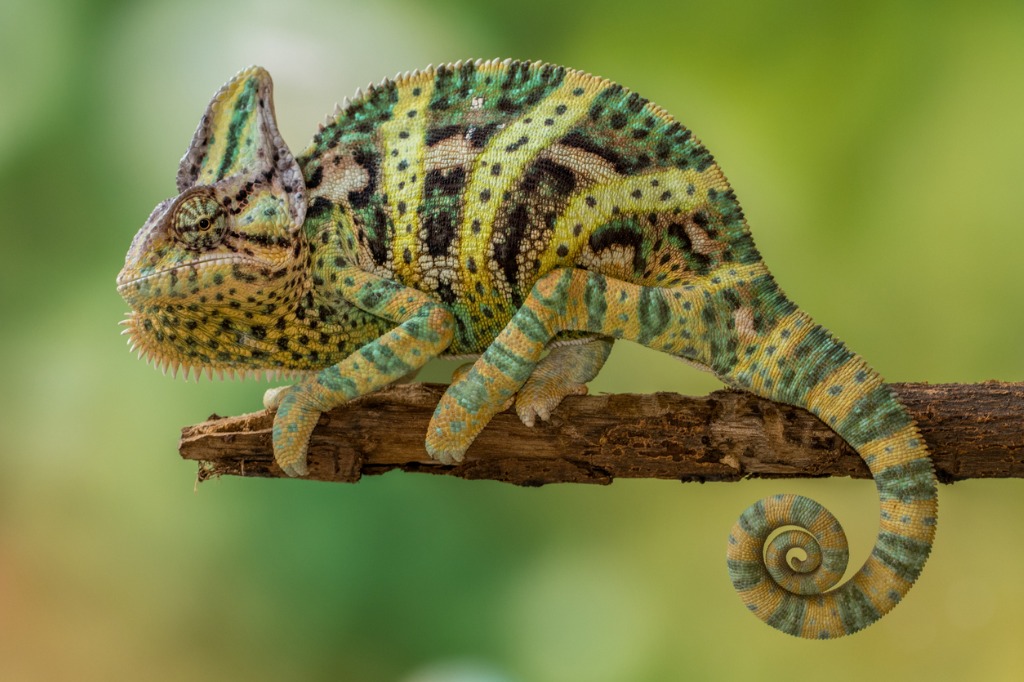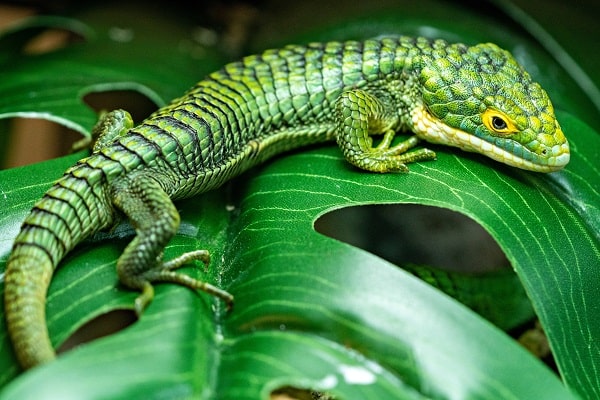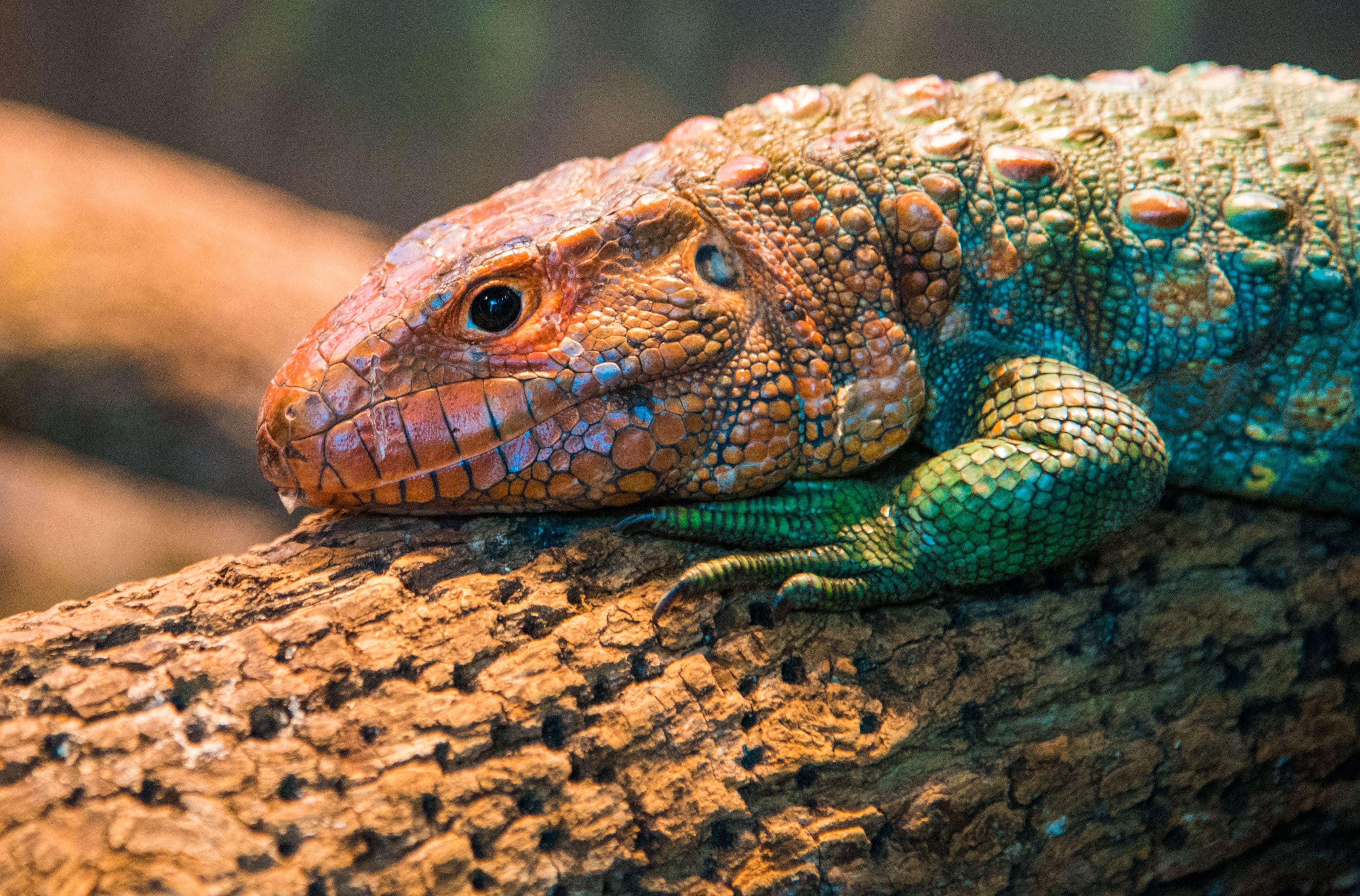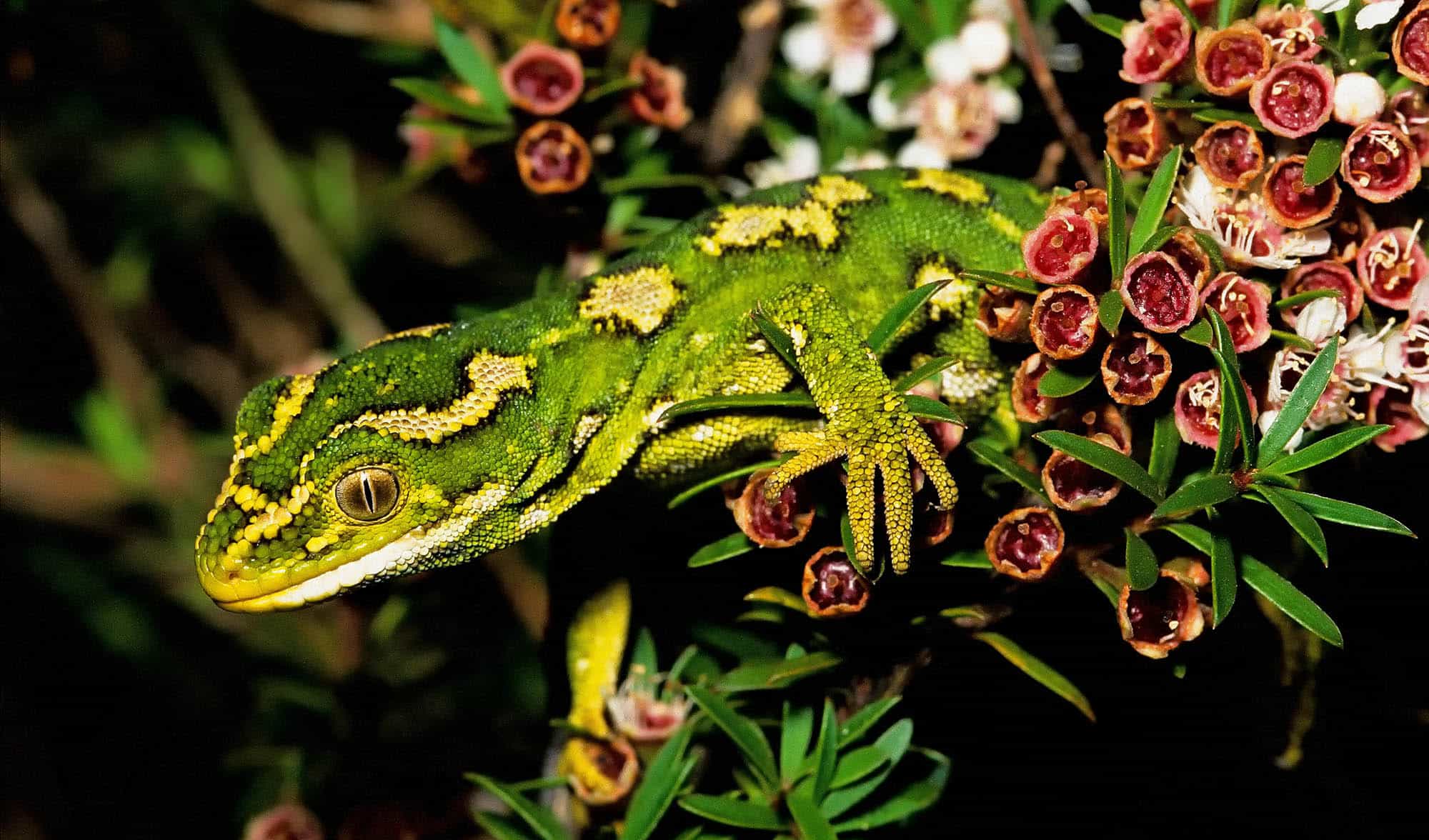Lizards are fascinating creatures that come in a variety of shapes, sizes, and colors. One of the most well-known and captivating colors that lizards can appear in is green.
Green lizards are not only visually stunning but also possess unique characteristics and behaviors that make them truly amazing. In this article, we will explore 10 types of green lizards, their interesting features, and the environments they inhabit.
You are reading: 10 Types Of Amazing Green Lizards
Let’s dive into the world of green lizards and discover the wonders of these incredible creatures.

10 Types Of Amazing Green Lizards
Mexican Alligator Lizard

The Mexican Alligator Lizard, also known as the Green Arboreal Alligator Lizard, is an endangered species of lizard endemic to the Sierra Madre de Oaxaca highlands of Mexico.
It can be found in the states of Puebla, Veracruz, and Oaxaca. This species adopts an arboreal lifestyle and is commonly found inhabiting the bromeliads among mesic cloud or pine-oak forest canopies. This habitat offers a humid temperate climate with summer rains.
The Mexican Alligator Lizard has a dorsoventrally depressed body with a flattened, triangular head and weak lateral fold. It can reach up to about 10.6 cm (4.2 in) in snout-vent length and 16.0 cm (6.3 in) in tail length.
The color patterns of this species can range from bright emerald green to dark teal blue, with juvenile coloration being a tan ground color with dark crossbands.
In terms of diet, the Mexican Alligator Lizard prefers a variety of insects. In the wild, it is known to feed on ants, beetles, spiders, and other small invertebrates. In captivity, a diet of crickets, mealworms, and other appropriately sized insects can be provided.
Due to its unique appearance, the Mexican Alligator Lizard is a popular choice among captive keepers. However, it is important to note that this species is endangered, and efforts should be made to protect its natural habitat and discourage illegal poaching.
Caiman Lizard

The Caiman Lizard, also known as the Dracaena lizard or water tegu, is a large, semi-aquatic reptile species that is native to South America. This genus has two species: Dracaena guianensis, also called the northern caiman lizard and the Guyana caiman lizard, and Dracaena paraguayensis, commonly called the Paraguay caiman lizard.
Here are some interesting facts about the Caiman Lizard:
– The Caiman Lizard has a green body and a reddish-orange head. It has a long, laterally flattened tail and raised, horn-like scales along its back that offer some protection from predators.
– This species is semiaquatic and spends part of its time in the water. They are excellent climbers and can whip their tails around and bite at would-be predators when threatened.
– The Caiman Lizard is a carnivorous species that feeds primarily on invertebrates, such as snails, crawfish, and freshwater clams. They are also known predators of Amazon river turtles.
– Caiman Lizards can make great pets, but only for experienced reptile keepers. Their jaws are so strong that a bite will likely require stitches, and they could even tear your finger off. They need a large enclosure, at least 8 feet long by 3 feet wide and 4 feet high.
– The Caiman Lizard is among the largest lizards, with the northern caiman lizard being the larger of the two species. They can grow up to 4 feet in length.
Caiman Lizards are fascinating creatures that require specialized care and attention. They are not yet commonly kept in private collections, but they are available for sale from some breeders and pet stores.
Jeweled Gecko

The Jewelled Gecko, also known as Naultinus gemmeus, is a threatened species of lizard in the family Diplodactylidae. It is endemic to the South Island of New Zealand, specifically the southeast region, with the main population found in Canterbury and Otago.
Read more : 10 Types Of Animals With Antlers
Here are some interesting facts about the Jewelled Gecko:
– Appearance: Jewelled geckos are beautiful, vivid green lizards with yellow and white markings. Some individuals have “diamond” markings, while others have two yellow stripes running along the sides of their back. Combinations of these two color patterns also occur. The eye color of Jewelled Geckos ranges from brown to olive.
– Size: These geckos can reach a total length of 18 cm (7.1 in), with the body usually measuring about 6 to 8 cm (2.4 to 3.1 in) from snout tip to anus (snout-to-vent length, abbreviated SVL).
– Habitat: Jewelled geckos are arboreal or terrestrial species that can be found basking in the foliage of tussocks, shrubs, vines, or trees. They typically inhabit dense spiny bushes such as Coprosma species, gorse, and manuka bushes.
– Behavior: These lizards are diurnal, meaning they are active during the day. They are insectivores and feed mainly on flies, moths, and beetles.
– Threats: The Jewelled Gecko is a highly protected species, and it is illegal to capture or disturb them. However, they are often targeted by wildlife smugglers due to their beauty and rarity. In the illegal pet market, a single gecko can be worth as much as $8000.
Jewelled Geckos are fascinating creatures that play an important role in the ecosystem. Efforts should be made to protect their natural habitat and discourage illegal poaching to ensure their survival.
Green Water Dragon
The Green Water Dragon, also known as the Chinese Water Dragon, is a species of agamid lizard native to southern China and mainland Southeast Asia. Here are some interesting facts about the Green Water Dragon:
Appearance:
– Green Water Dragons are bright green lizards with high horn scales that run from their head to the base of their laterally flattened tail. The tail is banded in brown and green and ends in a fine point.
– Males generally have more vivid coloring than females, including a bright orange to yellow area under the throat with pink tones near the lower jaw. Males also develop larger heads, jowls, and crests on the back and neck, and their femoral pores are typically larger than a female’s.
Habitat:
– Green Water Dragons are native to the subtropical forests of southern China and Southeast Asia, including Vietnam, Laos, portions of Cambodia, and eastern Thailand.
– They are semi-arboreal, spending much of their time in trees or plants, and are diurnal, meaning they are active during the day.
Behavior:
– Green Water Dragons are adept climbers and strong swimmers. They use their tail for balance and leverage when climbing, and whip it to defend against predators.
– When nervous or frightened, these lizards seek refuge in the water. They are strong swimmers and, if necessary, can remain submerged for long periods of time – sometimes up to 25 minutes.
Care:
– Green Water Dragons can make great pets, but they require specialized care and attention. They need a large enclosure, at least 6 feet long by 3 feet wide and 4 feet high, with a basking area and a water area deep enough for swimming.
– They are omnivores and require a varied diet of insects, fruits, and vegetables. In captivity, they can be fed crickets, mealworms, waxworms, and other appropriately sized insects, as well as leafy greens and fruits.
Green Water Dragons are fascinating creatures that require specialized care and attention. They are not yet commonly kept in private collections, but they are available for sale from some breeders and pet stores.
Jeweled Lacerta
The Jeweled Lacerta, also known as the Ocellated Lizard or Timon lepidus, is a species of lizard in the family Lacertidae. It is endemic to southwestern Europe, specifically the Iberian Peninsula. Here are some interesting facts about the Jeweled Lacerta:
– Appearance: Jeweled Lacertas are medium-sized lizards with bright green bodies overlaid with jewel-like blue spots and darker rosettes. They are known for their bright blue eyes and green skin. The typical Jeweled Lacerta ranges in size between 1 and 2 feet long, with their tails accounting for a significant portion of their total length.
– Habitat: These lizards are diurnal and terrestrial, native to the Iberian Peninsula of Europe. They can be found in a variety of habitats, including rocky areas, scrublands, and forests.
– Behavior: Jeweled Lacertas are known for their active and curious nature. They are agile climbers and can often be seen basking on rocks or in trees. These lizards are also excellent diggers and will create burrows for shelter and hibernation.
– Care: Jeweled Lacertas can make great pets for experienced reptile owners. They require a spacious enclosure with a temperature gradient, UVB lighting, and a substrate that allows for digging. Their diet should consist of a variety of insects, small vertebrates, and plant matter.
– Threats: While not currently listed as a threatened species, the Jeweled Lacerta’s population is declining due to habitat loss and fragmentation. Additionally, they are sometimes collected for the pet trade, which can impact wild populations if not done sustainably.
Jeweled Lacertas are fascinating lizards with their vibrant colors and active behavior. If you are considering keeping one as a pet, make sure you are prepared to provide the proper care and attention they need to thrive.
Green Anole
The Green Anole, also known as Anolis carolinensis, is a small to medium-sized lizard native to the southeastern United States and introduced to islands in the Pacific and Caribbean. Here are some interesting facts about the Green Anole:
Appearance:
– Green Anoles are slender lizards with a long, pointed head and ridges between the eyes and nostrils. They have adhesive toe pads that allow them to climb trees and other surfaces.
– They exhibit sexual dimorphism, with males being 15% larger than females. The typical coloration for a Green Anole ranges from bright green to dark brown, with little variation in between. They can change their color to several shades from brown to green.
Habitat:
– Green Anoles are arboreal and can be found in a variety of habitats, including forests, shrubs, and gardens.
– They are native to the southeastern United States, including Georgia and South Carolina, but have been introduced to other areas, including Hawaii and Guam.
Behavior:
– Green Anoles are diurnal and spend most of their day foraging for food. They are insectivores and feed on a variety of small invertebrates, including crickets, flies, and spiders.
– They are agile climbers and can often be seen basking on rocks or in trees. They are also capable of changing their color to blend in with their surroundings.
Care:
– Green Anoles can make great pets for beginners, as they are relatively easy to care for. They require a spacious enclosure with a temperature gradient, UVB lighting, and a substrate that allows for digging. Their diet should consist of a variety of insects, such as crickets, mealworms, and waxworms.
– They are skittish and shy, but with consistent and gentle handling, they can become somewhat tame. However, they prefer not to be handled too much, and always handle them gently.
Read more : Top 10 Smallest Snakes In The World
Green Anoles are fascinating creatures that are easy to care for and make great pets for beginners. If you are considering keeping one as a pet, make sure you are prepared to provide the proper care and attention they need to thrive.
Green Iguana
The Green Iguana, also known as the American Iguana or the Common Green Iguana, is a large, arboreal, and mostly herbivorous species of lizard of the genus Iguana. Here are some interesting facts about the Green Iguana:
Appearance:
– Green Iguanas are among the largest lizards in the Americas, averaging around 6.5 feet long and weighing about 11 pounds.
– Despite their name, Green Iguanas occur in different colors and types. In southern countries of their range, such as Peru, they appear bluish in color with bold blue markings. On islands such as Bonaire, Curaçao, Aruba, and Grenada, their color may vary from green to lavender, black, and even reddish-brown. Green Iguanas from the western region of Costa Rica are red, and animals of the northern ranges, such as Mexico, appear orange.
Habitat:
– The Green Iguana’s extensive range comprises the rainforests of northern Mexico, Central America, the Caribbean Islands, and southern Brazil. They spend most of their lives in the canopy, descending only infrequently to mate, lay eggs, or change trees.
– Although preferring an arboreal (forested) environment, they can adjust well to a more open area.
Behavior:
– Green Iguanas are primarily herbivores, feeding on foliage, flowers, and fruit. They occasionally eat a small amount of carrion or invertebrates.
– They are known for their basking behavior, often seen sunning themselves on tree branches or rocks to regulate their body temperature.
Care:
– Green Iguanas are among the most popular reptile pets in the United States, despite being quite difficult to care for properly. In fact, most captive iguanas die within the first year, and many are either turned loose by their owners or given to reptile rescue groups.
– They require a large enclosure with proper heating, lighting, and a varied diet consisting of leafy greens, vegetables, and occasional fruits. A well-maintained habitat and regular veterinary check-ups are essential for their well-being.
Green Iguanas are fascinating creatures with their impressive size and unique color variations. However, they are not suitable for everyone as pets due to their specialized care requirements.
If you are considering keeping a Green Iguana as a pet, make sure you are prepared to provide the proper care and attention they need to thrive.
Veiled Chameleon
The Veiled Chameleon, also known as Chamaeleo calyptratus, is a species of chameleon native to the Arabian Peninsula in Yemen and Saudi Arabia. Here are some interesting facts about the Veiled Chameleon:
Appearance:
– Veiled Chameleons are medium-sized lizards with a bony protrusion atop their head, called a casque. Both males and females sport the fancy headgear, which serves to channel water droplets down into the reptiles’ mouths, a crucial adaptation in their dry habitats.
– They have bodies that are banded in shades of green, yellow, and brown which adjust to varying shades.
Habitat:
– Veiled Chameleons are arboreal lizards, meaning they prefer to live high up in trees or lower near the ground in bushes and shrubs.
– They are native to the Arabian Peninsula in Yemen and Saudi Arabia, but have been introduced to other areas, including Florida in the United States.
Behavior:
– Veiled Chameleons are mostly insectivores, ambushing prey with long, sticky tongues. Their grasping feet and prehensile tails allow them to hold fast to branches, shrubs, or even backyard plants.
– They are territorial and aggressive to other chameleons, so they should always be housed individually. While they are usually quite docile towards people, regular handling tends to be stressful for them.
Care:
– Veiled Chameleons are more tolerant of captive conditions than other chameleon species, but are still challenging pets to keep healthy. They require a large enclosure with proper heating, lighting, and a varied diet consisting of insects, leafy greens, and occasional fruits.
– They are pets better suited to being watched rather than handled. These chameleons are not good pets for small children or for novice lizard owners.
Veiled Chameleons are fascinating creatures with their unique appearance and behavior. If you are considering keeping one as a pet, make sure you are prepared to provide the proper care and attention they need to thrive.
Green Basilisk
The Green Basilisk, also known as the Plumed Basilisk, Double Crested Basilisk, or Jesus Christ Lizard, is a species of lizard in the family Corytophanidae, native to Central America. Here are some interesting facts about the Green Basilisk:
Appearance:
– Green Basilisks are the largest basilisk species, with an average snout-to-vent length of 10 inches (25 cm) and a total length of up to 3 feet (91 cm) including the tail.
– Adults are brilliant green, with bright yellow eyes and small bluish spots along the dorsal ridge. Males have three crests: one on the head, one on the back, and one on the tail, while females have only the head crest. Juveniles are less conspicuously colored and lack the characteristic crests.
Habitat:
– Green Basilisks are found in the tropical rainforests of Costa Rica, Honduras, Nicaragua, and Panama. They are considered to be semi-arboreal and semi-aquatic, inhabiting elevations ranging from sea level to 2,542 feet (775 meters).
– These basilisks are often found near bodies of water and are never far from a water source. They are abundant in the tropical rainforests of Central America, from southern Mexico to Panama.
Behavior:
– One of the most remarkable abilities of the Green Basilisk is its ability to run on water, which has earned it the nickname “Jesus Christ Lizard.” When threatened, it can drop from a tree into the water and sprint, upright, about 5 feet per second across the surface.
– Green Basilisks are omnivores, surviving on a diet of plant material, insects, fruit, and small vertebrates. They are common throughout their range and have no significant population threats.
Care:
– Green Basilisks are sometimes kept as pets, but they require specialized care and a large, well-maintained enclosure with access to water for swimming and basking. They need a varied diet consisting of insects, fruits, and leafy greens.
– These lizards are not recommended for beginner reptile owners due to their specific needs and the challenges of providing a suitable environment for them.
Green Thornytail Iguana
The Green Thornytail Iguana, also known as Uracentron azureum, is an arboreal species of lizard found in the Amazon rainforest and forests in the Guiana Shield. Here are some interesting facts about the Green Thornytail Iguana:
Appearance:
– The Green Thornytail Iguana can reach about 9 cm (3.5 in) in snout-vent length and has a relatively short, spiny tail. It has three distinct subspecies, which sometimes have been recognized as separate species:
– The nominate subspecies is bright green with distinct blackish bands and is found in the northeastern part of the Green Thornytail Iguana’s range.
– The southwestern T. a. guentheri is duller with a greyish or brownish rear body and tail.
– The northwestern T. a. (subspecies not mentioned in the source).
Habitat:
– Green Thornytail Iguanas are native to the Amazon rainforest and forests in the Guiana Shield. They are found in Colombia, Guyana, Suriname, French Guiana, northeastern Peru, southern Venezuela, and northern Brazil.
– These lizards are arboreal, meaning they primarily live in trees, and are well-adapted to their forested habitats.
Behavior:
– Similar to the U. flaviceps, the only other species in the genus, the Green Thornytail Iguana primarily feeds on ants.
– They are relatively small and elusive lizards, often blending in with their surroundings and using their spiny tails for defense.
Conservation:
– The conservation status of the Green Thornytail Iguana is currently unknown, and more research is needed to assess its population and threats.
FAQS
1. Can green lizards change their color?
Yes, many green lizards, such as chameleons and green anoles, have the ability to change their color. This adaptation helps them blend in with their surroundings and can be influenced by factors like mood, temperature, and habitat.
2. What is the lifespan of a green anole?
Green anoles have an average lifespan of 2 to 8 years, with proper care and nutrition playing a significant role in their longevity.
3. Are green anoles good pets for children?
Yes, green anoles are popular “starter” pets for children. They are relatively easy to care for, and their willingness to interact with their owners, such as eating from their hands, makes them fun to watch and handle.
4. What do green basilisk lizards eat?
Green basilisk lizards are omnivores, feeding on a diet of plant material, insects, fruit, and small vertebrates.
5 Where can I find green anoles in the wild?
Green anoles are native to the southeastern United States and can be found in states such as Tennessee, Louisiana, Georgia, Florida, the Carolinas, and Texas.
6. How big do green basilisk lizards grow?
Green basilisk lizards, also known as plumed or double-crested basilisks, can reach a size of about 2 feet in length, including their long, whip-like tail.
7. Are green anoles true chameleons?
No, green anoles are not true chameleons, although they share the ability to change their color. They are a separate species known for their emerald-green backs and pink “dewlaps” (pouches under their chins).
8. Do green anoles have a blue tint?
Occasionally, green anoles may have a blue tint, adding to their unique and attractive appearance.
9. How should I handle a green anole?
When handling a green anole, it’s important to avoid grabbing them by the tail. Instead, teach children to pick them up by gently supporting their body and allowing them to perch on a hand or shoulder.
Source: https://petstutorial.com
Category: Animals










